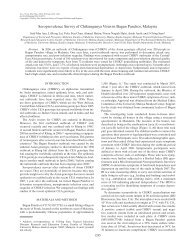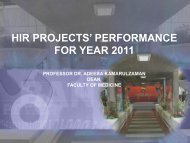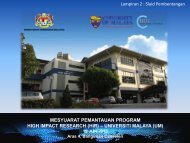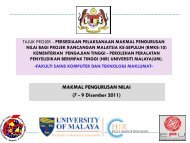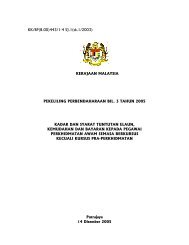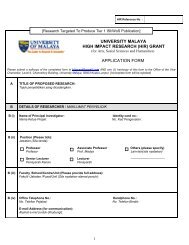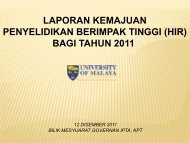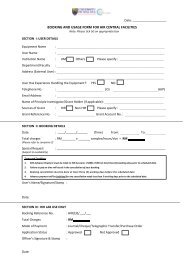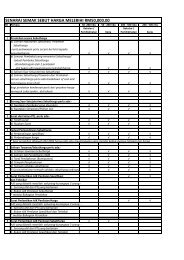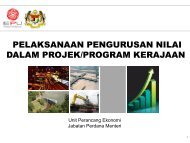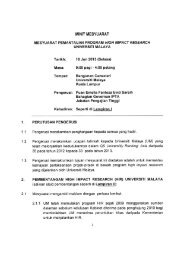CHONDROGENIC PRE-DIFFERENTIATED AND UNDIFFERENTIATED MSCs IN CARTILAGE REPAIR 1339(11.8 1.47 vs. 8.67 1.86). However, there were nosignificant differences in these scores between theMSC and CMSC groups at 3 and 6 months (Table 1).The histology of the repaired sites obtained fromthe MSCs group after 3 months demonstrated a thinlayer of neocartilage forming and contained clusteredcells within the immature tissue (Fig. 2A). Therepaired tissue from CMSCs group at 6 months containedboth fibrocartilage and hyaline cartilage(Fig. 2C). In the control sites, the defects did notappear to undergo any repair process (Fig. 2B) or wereonly filled with fibrous tissue (Fig. 2B). Some sitesdemonstrated incomplete repair with hyaline like cartilage,but there were no vertical integration of thistissue with the subchondral bone. In some parts, thedefect was filled with bone (Fig. 3B). This repair tissueat 6 months demonstrated early signs of degenerationwith the presences of vertical fissures in the neocartilage(Fig. 3D). Immunohsitochemical staining showedhigher concentration of type II collagen in the transplantedtissues in both MSC and CMS than those inthe control sites (Fig. 3).The GAG content of the repaired tissue was verifiedqualitatively using Safranin O Fast green staining. Inthe transplanted groups, the repaired tissue stainedmore intensely for GAG within the intermediate anddeep zones as compared to that of the control sites(Fig. 4).Sulfated Glycoaminoglycans (GAG) AnalysisThe results of GAG quantitative analysis are summarizedin Table 1. Consistent with the morphological andhistological scores, the mean levels of GAG/proteinwere higher in the treated knees as compared to thecontrol knees at 3 and 6 months post-transplantation,Figure 2. Histology of the defect site of the rabbit’s knee inMSC-treated group (A,B) and CMSC-treated group (C,D) after 3and 6 months, respectively (H&E 10): Arrows point therepaired tissue in the right knees after 3 and 6 month ofimplantation.with no significant differences noted between the 2MSC groups at 3 months post-transplantation. Interestinglyhowever, there was a trend towards a higherGAG/protein level in the MSC group (1.67 0.14)compared to the CMSC groups (1.29 0.38), with thedifference being marginally close but did not reach thesignificance threshold (p ¼ 0.052).DISCUSSIONMesenchymal stem cells exhibit a stable phenotype invitro and have multilineage potential of differentiatinginto the adipocytes, chondrocytes, or osteocytes. 21 Invitro studies have suggested that the induction ofadult stem cells into chondrogenic lineage could beachieved via the introduction of soluble, biophysical,and 3D culturing environment factors. 22 The characteristicsof CMSCs were described in previous studies,which demonstrates an up-regulation of chondrogenicgenes, which included Sox9, COMP, as well as theexpression of GAG and type II collagen. 5,16 In thisstudy, the results demonstrated that CMSCs producedgood quality cartilage tissue as compared to theuntreated knees. Despite the ability of CMSCs to producebetter histological repair outcomes than MSCs,these differences were not significant. It may havebeen the case that the use of alginate gel for transplantingMSCs may have induced chondrogenic differentiation.It has been previously demonstrated thatalginate can independently induce chondrogenesis inBM stromal cells without the need of other stimulatingfactors. 23 The ideal microenvironment provided by thealginate gels has been shown to increase the cell–matrix signaling, which initiates and promotes the cellulardifferentiation process. 24 Because both cells typeswere encapsulated in alginate gel, the 3D environmentprovided by the alginate gel may have maintained therounded cell shape, thereby promoting chonrogenesis.22 It has been shown that the differentiation ofMSCs into a chondrogenic phenotype requires the cellsto maintain a rounded shape, which can be achievedthrough pellet encapsulation within a semi-solidmaterial, such as that provided by the alginate gel. 25The round nuclear shape of MSCs obtained in thisenvironment has been associated with a high level ofexpression of the chondrogenesis molecular markers. 15In addition, alginate gel encapsulating MSCs werepreviously shown to be associated with an increaseexpression of type II collagen and aggrecan genes andnot of collagen type I. However, it is interesting to notethat an increase in GAG/protein in both MSC- andCMSC-treated knees almost demonstrated a significantdifference between the two treatment groups at6 months with a p-value of only 0.052. There appearsto be a remarkable increase in GAG/protein for theMSC-treated group, exceeding that of the CMSC groupwhen cells are left in vivo for 6 months duration. Itmay have been the case that prolonged chondrogenicdifferentiation in vitro may have resulted in the lost ofJOURNAL OF ORTHOPAEDIC RESEARCH SEPTEMBER 2011
1340 DASHTDAR ET AL.Figure 3. Immunohistochemistry for collagen type II for MSC-treated group (A,B), CMSC-treated group (C,D), and normal cartilage(E,F) 10. (A) The defect of the left knee after 6 months, the repaired cartilage has no vertical integration with subchondral bone, itcontains scarce amount of collagen type II. (B) Collagen type II is deposited (stained brown) in the repaired cartilage. (C) Repairedtissue of the left knee shows an irregular immature cartilage mass with clustered cells and low amount of collagen type II, a part of thedefect has been replaced by bone (arrow). (D) The repaired tissue of the right knee contains a great amount of collagen type II especiallyat superficial layer (arrow). (E) Normal cartilage negative control (stained without collagen type II antibody). (F) Normal cartilagepositive control type II collagen is more abundant in superficial and deep zones.the MSC’s chondrogenic potential when transplantationwas performed in rabbits. Nevertheless, thisissue remains speculative and warrants furtherinvestigation.In the present study, the gross morphologicalappearances of smoother and more homogenous regeneratedcartilage tissues in the MSCs-treated knee indicateda superior tissue repair following MSCtreatment compared those left untreated. This findingwas consistent with previous reports demonstratingsatisfactory repair of damaged cartilage with the useof MSC, even in conditions involving osteochondraldefects. 1–4 The question however remains as towhether the observed enhanced cartilage repair was adirect result of the transplanted MSCs or merely aconsequence of augmented expansion of the surroundingcells, for example, chondrocytes/progenitor cells orextracellular matrix, contributing to the healing process.20,26 To the best of our knowledge, this issue hasnot been specifically addressed in any previouspublications.The histological analyses of the present study identifiedclear differences between the MSC-treated anduntreated knees. The MSC treatment appeared toinduce a greater amount of type II collagen formation.In contrast, the repaired tissue of the untreated kneeshowed an irregular immature cartilage mass withclustered cells and low amount of collagen type II. Inaddition, the repaired tissue treated with MSCscontained a vast amount of GAG in the intermediateand deep zones, whereas the untreated regeneratedtissue showed only scarce amount of GAG. Similarobservations were reported in previous studies, demonstratingthat cartilage treated with MSCs had extracellularmatrix that primarily consisted of a hyalineand fibro-cartilage mixture, while the untreated cartilagedefects were composed of merely a thin layer offibrous tissue. 23,26There are a number of limitations in the study thatare worth highlighting. The present study utilized onlya limited numbers of animals as a consequence offinancial constraints. This prohibits the use of parametricstatistical analyses, which would in effect, producemore convincing results, and thereby strengthenthe conclusions derived from the analyses. In addition,the constraints related to the availability of resourcesallowed assessment of cartilage repair only at 2 timepoints, that is, 3 months and 6 months post-surgery. Alarger number of observational time points that shouldideally be performed would provide further informationregarding the temporal evolution of the repairprocess, providing a better insight into the actualeffect of MSC on the long-term outcome of cartilagerepair. The present study did not specifically distinguishthe contributing effect of alginate on the cartilageregeneration. Improvement to the study designby introducing another treatment arm involving theuse of alginate without cells would be desirable toJOURNAL OF ORTHOPAEDIC RESEARCH SEPTEMBER 2011



